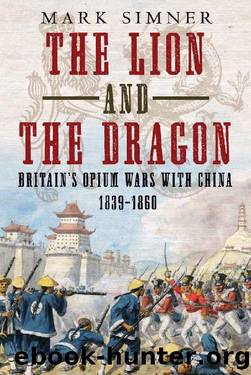THE LION AND THE DRAGON by Mark Simner

Author:Mark Simner [Simner, Mark]
Language: eng
Format: epub
ISBN: 9781781557174
Publisher: Fonthill Media
Published: 2019-06-27T23:00:00+00:00
8
Renewal of Hostilities
Despite the huge concessions the British exacted from the Chinese in the immediate wake of the First Opium War, the Treaty of Nanking quickly became inadequate for the British. Pottinger and Qiying, therefore, negotiated and agreed a supplementary treaty, which was signed on 8 October 1843. This additional treaty became known as the Treaty of the Bogue, as it was signed on the Bogue, and contained a total of seventeen separate articles. However, it essentially laid out more detailed regulations regarding trade between Britain and China, as well as the terms under which British citizens could conduct their business at the ports of Amoy, Canton, Fuchow, Ningpo, and Shanghai. Merchants would be allowed to reside in these ports with their families (there would be no ban on women) but it was agreed that they âshall not go into the surrounding Country beyond certain short distances to be named by the local Authorities, in concert with the British Consul, and on no pretence for purposes of traffic.â In addition, Britain was given what was known as âMost Favoured Nationâ status, which guaranteed Britain would be granted any additional privileges agreed between China and other powers. The supplementary treaty also included an extraterritoriality clause, which granted British subjects, and any Chinese in their employ, exemption from Chinese law for any crimes they might commit on Chinese soil. Instead, offenders would be tried and, if found guilty, punished according to British law. The Treaty of the Bogue would join the Treaty of Nanking as one of the Unequal Treaties. A full transcript of the treaty can be found in Appendix V.
It was not only the British who were conducting treaties with the Chinese in the aftermath of the First Opium War. The Americans concluded the Treaty of Wanghia (Wangxia) with the Chinese on 3 July 1844. This agreement was sought by the Americans, who had become concerned that Britain was dominating trade with China. The then US president, John Tyler, received numerous pleas from American merchants in China to act, and so he sent Caleb Cushing, a forty-four-year-old congressman from Massachusetts, to seek from the Chinese similar rights to those granted to Britain. Cushing met with Qiyling for talks in June, during which Peter Parker, an American physician and missionary, acted as interpreter. The negotiations went well, and Cushing and Qiyling subsequently signed the treaty in the Kum Iam Temple, which was located in the village of Wanghia, Macao, from where it gets its name. The Treaty of Wanghia was closely modelled on both the Treaties of Nanking and the Bogue, although it went into greater detail than the British agreements, having some thirty-four articles in total. It gained fixed tariffs on trade for American merchants, who were now also allowed to purchase land and build premises at the same five port cities where the British traded. Also, like the British treaties, it secured for the Americans âMost Favoured Nationâ status and extraterritoriality rights. In return, Cushing agreed that the US would not illegally trade in opium with China.
Download
This site does not store any files on its server. We only index and link to content provided by other sites. Please contact the content providers to delete copyright contents if any and email us, we'll remove relevant links or contents immediately.
The Radium Girls by Kate Moore(10914)
The Templars by Dan Jones(4191)
100 Deadly Skills by Clint Emerson(4084)
Rise and Kill First by Ronen Bergman(4016)
The Doomsday Machine by Daniel Ellsberg(3736)
The Rape of Nanking by Iris Chang(3518)
Killing England by Bill O'Reilly(3459)
Hitler in Los Angeles by Steven J. Ross(3442)
Stalin by Stephen Kotkin(3089)
12 Strong by Doug Stanton(3059)
Hitler's Monsters by Eric Kurlander(2735)
Darkest Hour by Anthony McCarten(2649)
Blood and Sand by Alex Von Tunzelmann(2610)
The Art of War Visualized by Jessica Hagy(2415)
Hitler's Flying Saucers: A Guide to German Flying Discs of the Second World War by Stevens Henry(2298)
The Code Book by Simon Singh(2214)
The Second World Wars by Victor Davis Hanson(2136)
Babylon's Ark by Lawrence Anthony(2073)
Tobruk by Peter Fitzsimons(2064)
